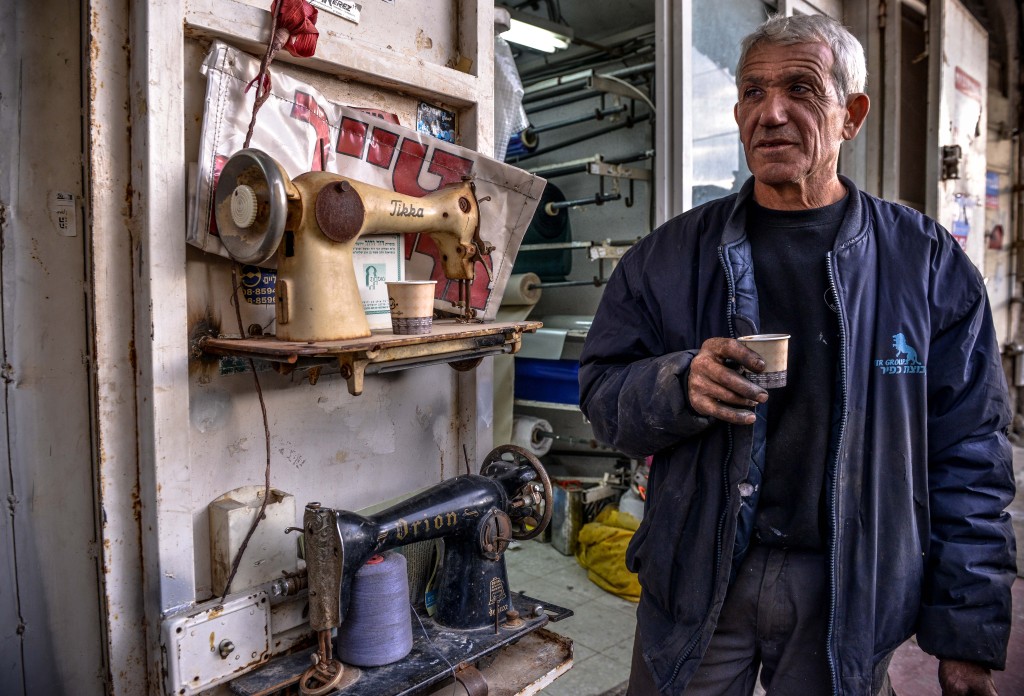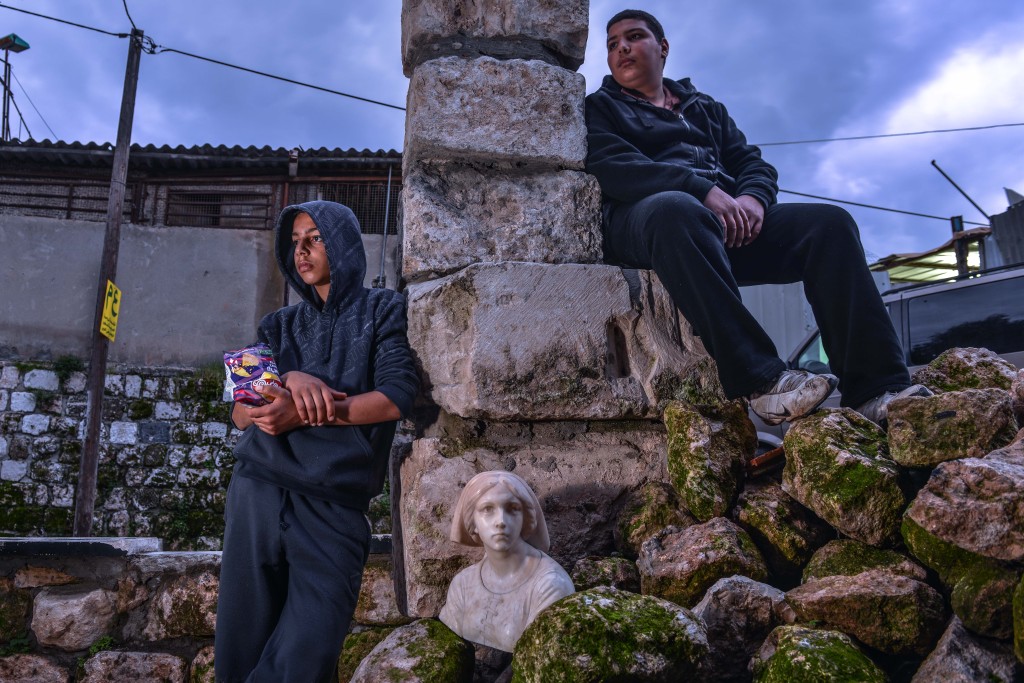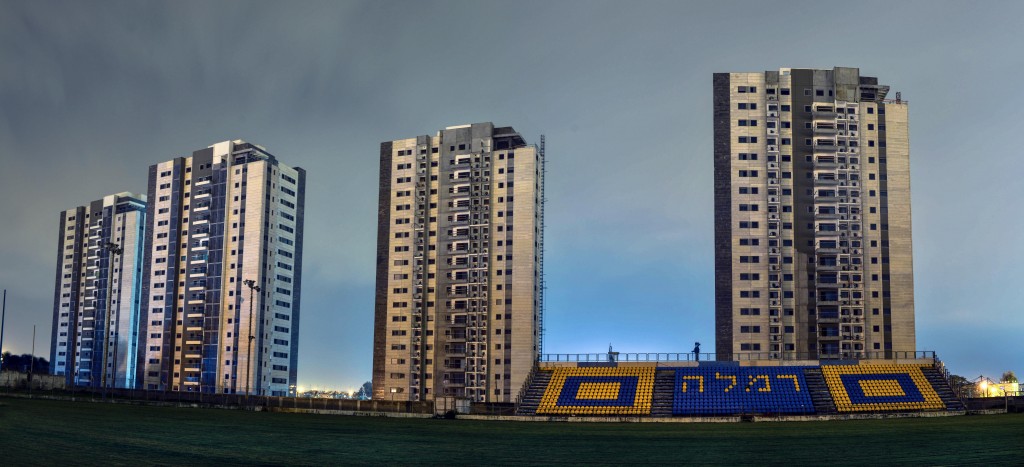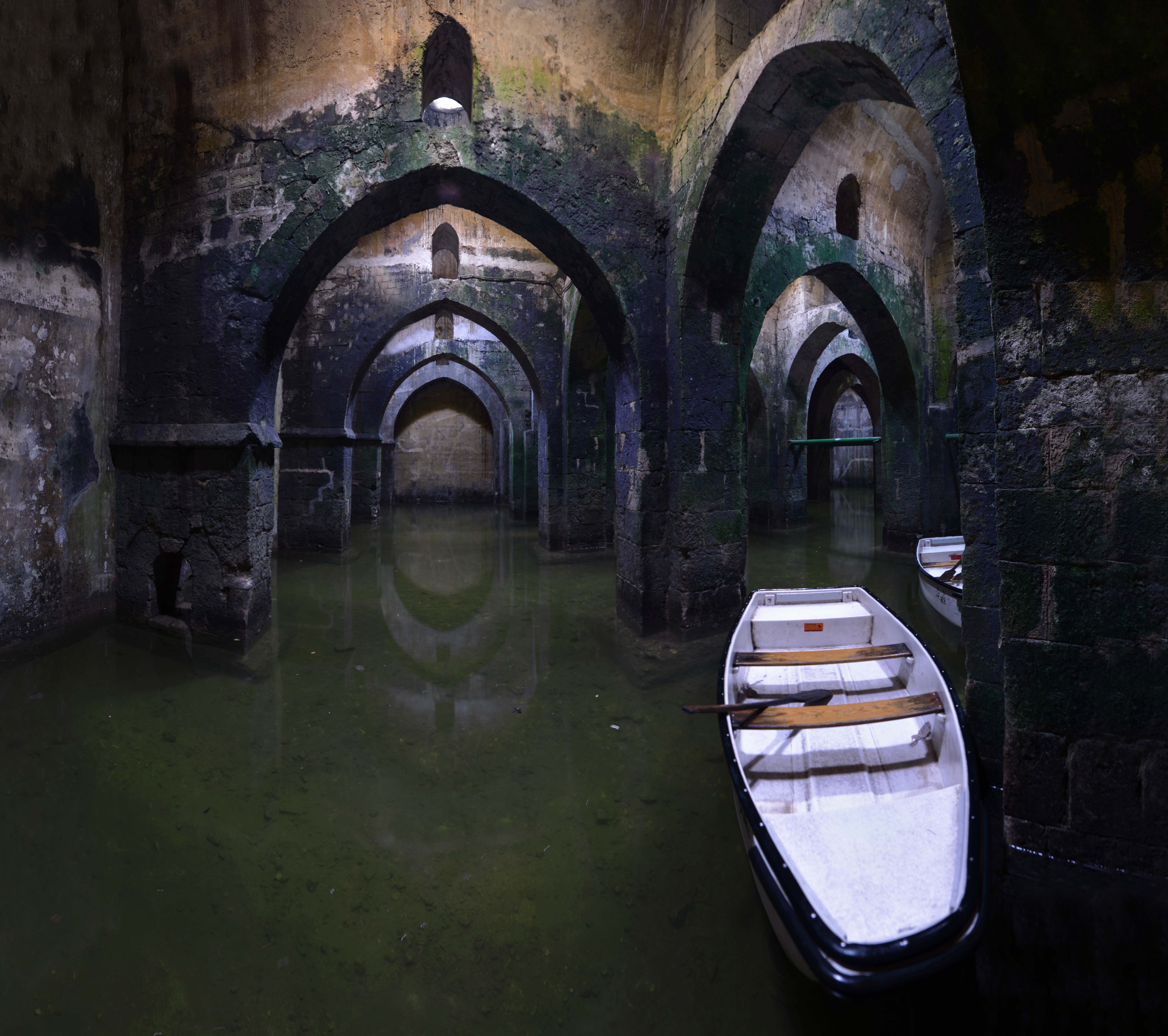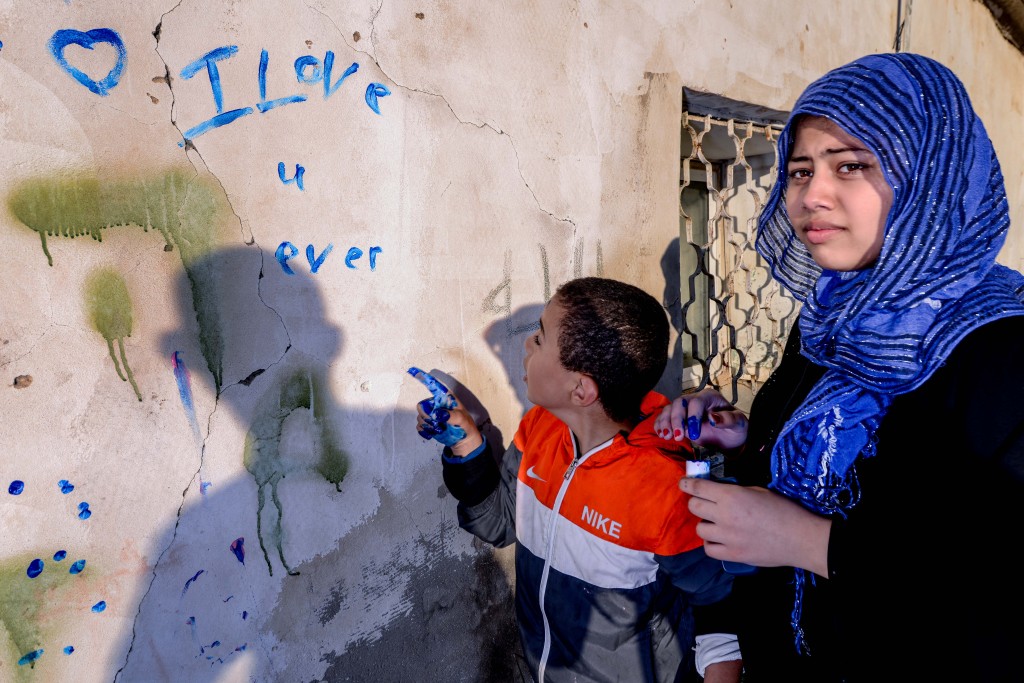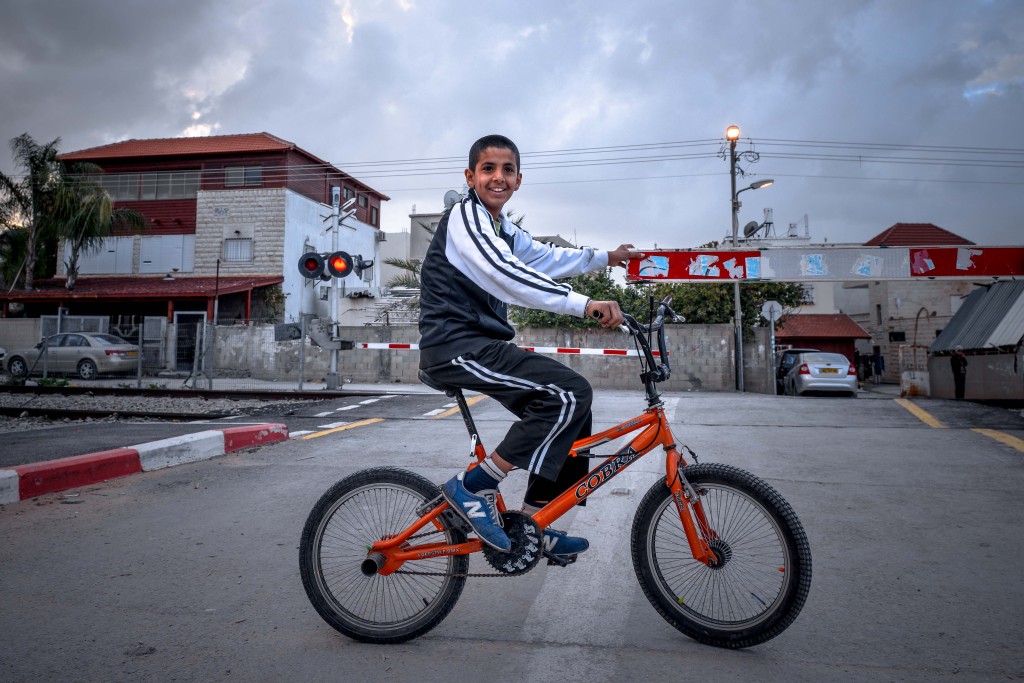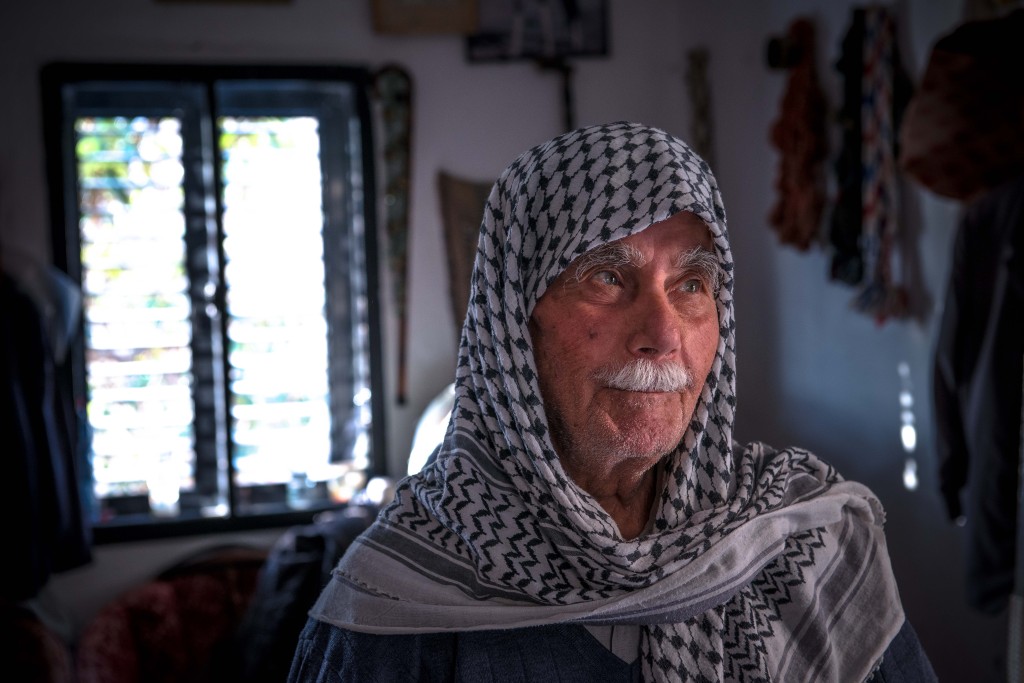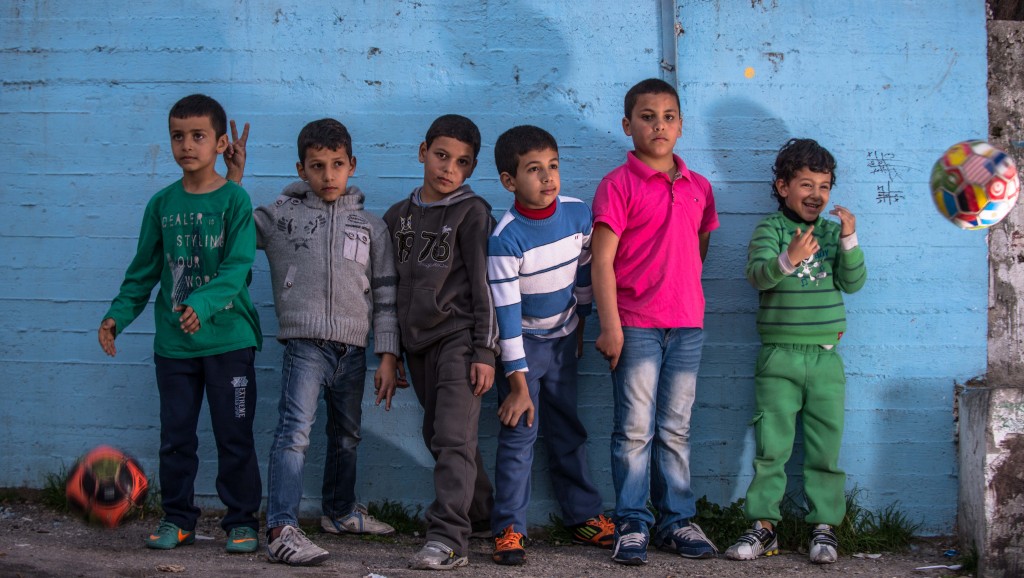If you look past the crazy bustle of Tel Aviv and the devout excesses of Jerusalem, a trip to the Israeli heartland reveals a completely different country.
This is a tale of more than two cities. It’s a story of places that bear unfamiliar names – Ramle, Lod, Dimona, Shfaram – places where life is obscured by the shadows of Tel Aviv, Nazareth, Beersheba, Haifa and, of course, Jerusalem. Like upturned stones, the bric-a-brac architecture, haphazard public squares and strange blend of people give these small cities an ephemeral flavor – as if they were the kind of motley market towns that used to come and go with the drift of commercial winds; as if they were waiting for the stone to be turned back over.
But a more careful look reveals a different side to these lost cities. While their respective clichés might reflect a portion of reality – Ramle and Lod, centers of crime; Shfaram, a far-off elf village of coexistence; Dimona, a Black Hebrew hub encircled by nuclear wasteland – what can be found in them is not just a separate Israel, but the makings of an Israel that can be, and one that may already be emerging.
For the past thirty years, since the rise of the Israeli metropolis, Israel’s two urban antipodes – Tel Aviv and Jerusalem – have dominated the public consciousness. Thus, the country is understood as either the stern, martyr-making seat of austerity that is Jerusalem or as Tel Aviv’s colorful, cultural sophisticate who’s not afraid to show a little skin.
But beyond the division between the ultra-religious and hyper-secular, Tel Aviv and Jerusalem also embody the ethnic divisions that are a favorite subject of international news stories and academic symposia. And to an extent, this is correct. For all the ethnic Kumbaya sung on the streets of Tel Aviv, Arabs and Jews there live, work, eat, and celebrate apart from one another. And while Jerusalem might bring the two groups into constant contact, the contact is often more clash than cooperation.
Together, Tel Aviv and Jerusalem, which make up about 12 percent of Israel’s eight million inhabitants, do play a huge role in shaping public life. (By comparison, America’s two largest cities, New York and Los Angeles, account for just three percent of the total population.) But Israel’s smallest cities – those which have less than 100,000 residents – together comprise about one third of the country.
Despite their small sizes, some of these cities have a real place in the Israeli zeitgeist. The are those, like Eilat, which are famous; those that are posh, like Herzliya; others, like Ma’aleh Adumim, are at the center of national controversy; while a select few – Nazareth, Tiberias – still bear the lore of their ancient and illustrious names.
But then there are the others, the places that aren’t on the tour bus circuit and receive scant mention in the guidebooks (and even less of their flowery guidebook prose). They don’t depend on tourism, but on industry. They aren’t destinations, but waypoints and crossroads. Their histories, while sometimes deep, are relatively unknown. And they are more often the butt of local jokes than topic of conversation. But though the lives of these cities are unexamined, they do in fact exist.
Perhaps no Israeli city embodies this nearly nameless existence as Ramle does. Located in the center of the country, just a few miles from Tel Aviv and its burgeoning property bubble, Ramle should – or, in a different world, could- – be something closer to neighboring bedroom communities like Rishon LeZion, where young, educated professionals go to start their families in mid-rise apartment buildings amid leafy streets and park-hedged squares.
But Ramle is something entirely different. Stepping off the train from Tel Aviv, the character of the city can be felt instantly. British Mandatory buildings made from heavy stone blocks line the road adjacent to the station where secular Israelis of various provenance, Arab women in hijabs and boys in tracks suits, as well as religious Jews in dark, long dress, walk to and from the shared taxis standing outside the city market.
In the market itself there’s a blend of life and activity: Ethiopian women in small shops in alleys, sorting through burlap bags filled with spices, grains, legumes, and the un-roasted beans of coffee; Russian immigrants hawking dried fruit and licorice; greengrocers selling outlandishly large radishes; an elderly rabbi waking from a mid-afternoon nap on his motorized scooter to shake a can of alms; and young girls wearing low-slung sweat pants studded with rhinestones on the way to the salon or a neighborhood tailor.
At night or in the rain the effect of the place is even more powerful, as the haloes of lamplight blend all the features pointillistically, evoking the idea that there is more to Ramle than the eye can see. And indeed there is. Though Ramle today is a mixed Israeli town of 70,000 middle-class people, it has been, at times, one of the most important outposts of the Middle East.
Founded in the eighth century, Ramle was the capital of the Ummayid dynasty and later emerged as the principal seat of Islamic power opposing Crusader-ruled Jerusalem. Its Ummayid builders created in it a functional and aesthetic marvel, building massive subterranean water-storing cisterns, which remain to this day. Ramle has also been witness to important events in modern history, including the birth of Abu Jihad, one of the founders of the Palestinian Fatah party, and the death of Adolf Eichmann, who was hanged there.
Today, the city is a mesh of crumbling stone walls, aluminum siding, stuccoed storefronts, crooked business signs and steel-shuttered stalls, all of it improbably strung together by electricity lines and occasionally pierced by a rising minaret or church spire. Beyond its initial Mideast-backwater romance, it looks like a place people shouldn’t enjoy living in. It looks like a place the young would try to flee. But its residents tell a different story.
“They are excellent,” Moshe Kaufman, who runs a one-shekel store opposite an Arab church, says when asked about relations between different groups in the city. It’s a refrain heard so often in response to this question that it begins to sound like a bit of a gloss. But as young Arab children drift in and out of the store buying candy and party favors, the normalcy of the interaction is apparent. The children are friendly and Moshe, a taciturn middle-aged man, is calmly matter-of-fact with them.
“You see who comes in here?” he says. “They are Arabs. Without Arab business, the shops in this city would go to pot. During the holidays – Ramadan for the Muslims, Christmas for the Christians – it’s true to even greater degree.”
Which is all very well – that Muslims, Christians and Jews get along because they have to buy products from one another; that they coexist with each other the way the city’s poor subsist on vegetables and cheap grains – because there’s simply no other choice. And that is a facet of life in Israel’s small cities. Where Jews and Arabs of Tel Aviv can keep their distance by divvying up the city, the way London or Los Angeles is divided into rule-bound neighborhoods, in a town that can be compassed in a few short minutes, preventing a functional blend of people is next to impossible.
But when asked, Kaufman says that relations in the city go beyond baseline tolerance. “Jews are invited to Arab weddings, and Arabs are invited to Jewish weddings,” he says. “Here, where we’re standing, used to be an Arab ghetto. Today it’s mixed. Ramle is a different world.”
Tayar Brazentin, a Likudnik who is proud of his Uncle Avram’s former friendship with Menachem Begin, says, “I used to be very right wing. I came here and met a lot of Arabs, and now I see things differently.” Brazentin, who fought in Israel’s 1967 Six Day War and the 1973 Yom Kippur War, says that though he once fully supported the settlements, today he believes settlers should move to towns like Ramle.
It’s not just the ethnic relations that the people in Ramle are proud of – it’s also “the good life” that Ramle’s residents insist exists there, in spite of the city’s reputation as a violent, cultureless quagmire.
Rami Ben Shalosh steps out of his furniture shop where an enormous, antique-looking band saw stands by an open garage door, and extends a hand powdered by sawdust. Ben Shalosh grew up in Ramle during a different time – the 1980s, when the city was more divided, but when it was also something of a cultural hotspot where kids from Tel Aviv came to party.
Today, Ben Shalosh lives in Tel Aviv, where he moved after he married a Tel Avivian woman. But he says that although Ramle used to be the ghettoized blight it’s still known as, he’s seen significant change over the years.
“The city has become more democratic,” he says. “They live here, we live here. We have to get along,” he adds, referring to the city’s mixed population. But he also notes the standard of living compared with Tel Aviv – where the idea of running a hand-made furniture shop in the looming shadow of IKEA is next to absurd – offers residents and business owners a little bit of oxygen.
It’s the more reasonable rents and mortgages, as well as the price of business supplies, food, and pre-schools that enable residents to support local businesses like Ben Shalosh’s furniture shop, but also to develop their own lives and relationships with each other.
“The Arabs in Ramle today have houses and cars,” Ben Shalosh says. “They go out, the women go to beauty salons. They’re looking less at religion and they seem more free. The Muslims have a more difficult situation [than the Christians] but they’re also opening up.”
“It really is the good life here,” says Saul, who runs the same kebab restaurant on a hidden corner in Ramle that was opened by his father 65 years ago, before the State of Israel was founded. Sweeping up and washing the pile of dishes after the busy lunch hour, Saul and his wife express a rare and almost tender pride for their city, especially when it comes to relations between people.
“You see who was here, the man who just left? He’s an Arab man, a friend of mine. He comes almost every day and stays for hours,” Saul says. “No one here differentiates between this one and that one. We’re all together.” When asked why he thinks this is so, he refers to one element that almost every resident of Ramle agree on: “It’s the mayor. He’s a good person. He wants to help. You’ll see how nice he is.”
The mayor, Yoel Lavi, likens himself to an onion. It’s in response to a question from an American visitor about growing up in Brooklyn, where the gentle Yiddish curse, “May you grow up like an onion with your head in the ground,” was heard not infrequently. The visitor, a New Yorker, asks the mayor how he guessed her background is Polish. “It’s all the same,” he says, referring to the patterns of recent Jewish history.
Lavi has been the mayor of Ramle for more than twenty years. Though his military and political careers brought him in contact with the highest echelons of power, he is today wedded to his city. He tells a story to explain how governance works there: One day, during his first term, a man was standing at the window on the fourth floor of an apartment building threatening suicide. Outside, a crowd of more than 150 people, including children, had gathered to watch the spectacle. So the emergency services did what came naturally to them – they called the mayor.
“I went up there and told the man, ‘I’m going down to the second floor to have coffee,'” (at the apartment of a family he knew at the time). “‘If you want to come down and talk, I’ll be there in ten minutes,'” he told the man. Ten minutes later, the jumper showed up for coffee – and to talk.
It might seem like a tale out of a book of Yiddish fables, but in some ways it’s representative. While in Tel Aviv and Jerusalem the vast majority of residents have never so much as seen their mayor, in Ramle governance is about interaction.
“You have to give residents the feeling they belong. You give them the feeling that they are part of the city’s decision-making process,” Lavi says, noting that his administration’s decision to bring members of the Arab community onto the city’s steering committees has been a decisive factor in improving relations. “They’ve taken this idea and they’ve done it themselves, building their own committees and councils of leaders to take care of unique issues and unique needs.”
He explains, by way of example, that Ramadan can sometimes coincide with Tish B’Av, which is a day of mourning in the Jewish calendar when shops in Israel are legally mandated to close the night before the commemoration. But after a day of fasting, Muslims of Ramle depend on stores and restaurants to be open for the customary evening celebration. So the Muslim council works with the city to obtain permits for stores and restaurants to open; meanwhile, the same councils work to educate Arab residents about the need to be respectful of Jewish customs on Yom Kippur.
“The first duty of the city is to serve the values of life and the quality of life of the citizens – to improve it,” Lavi says. “We don’t wait for the official green light to do what’s needed.”
A few minutes north, Lod lies waiting. It’s been waiting there for 6,000 years, with six millennia of continual inhabitance at the very center of Israel’s central plain attested to by pottery shards that date the city back to the Canaanite period, as well as by its own mention in the Book of Ezra: “The children of Lod, Hadid, and Ono, seven hundred twenty and five,” the book reads in a census of Israelite exiles who returned to the Holy Land after the Babylonian captivity.
In 1996, one of the most breathtaking Roman mosaics ever discovered was found during highway construction near Lod. It’s tempting to call the Lod Mosaic, as it’s now known, a metaphor for the city itself: brightly mixed bits of everything forming a pleasing whole. But to do that would be to sell Lod short, to make it a kind of Berkeley of the Middle East.
Understanding Lod takes a closer, and more literal, look at its namesake mosaic, which shows a menagerie of fish, fowl, birds of prey, carnivores, and even giraffes and elephants, many of them in “savage encounters” (as the New York Review of Books put it), all set into a geometric background so minute and complex that it seems to be in flux. That is Lod.
By day, the city’s Muslims, Christians, and Bedouin; its Sephardic Jews, Russian immigrants, Ethiopians, Hasids, and even the more newly minted Ashkenazi kippah srugah, or national religious, meet, hug each other, laugh, chat, and sip coffee. But at night the savage encounter begins.
Lod goes beyond Ramle’s punch line as an urban quagmire and has become in the Israeli consciousness more of a cautionary tale. It’s Brooklyn in the 80s, or Baltimore as we know it from The Wire. The city even has its own Wire-style documentary series focusing on the grit and grime of Israel’s murder capital.
When a journalist from Israel’s Channel 2 News asked one of the city’s previous mayors, Ilan Harari, a former IDF brigadier general who had commanded a number of combat brigades – but, until Lod, had no political experience – whether it was his army experience that got him appointed mayor by a selection committee, he paused and then answered: “I think my military background helps me here.”
But Lod’s residents say the city’s reality belies the reputation. “In Lod, it’s about respect,” said Yehuda Menasheh, a Jewish fruit seller in Lod’s market who laughs between sentences as he stands behind his market stall piled high with fruit and vegetables. “Whoever gives respect, gets respect. It doesn’t matter if you’re Jewish, Arab, Christian, Muslim – whatever. It’s a matter of respect. And whoever says there’s anti-Semitism here is bluffing.”
Like many of Ramle and Lod’s Jewish residents, Menasheh identifies himself as a supporter of Benjamin Netanyahu’s Likud party, despite the fact that in conversation he sounds closer to a member of the left-wing Meretz party. “I’m for peace – nothing else,” he says. “Just that there’s peace in this country, and in the word.” When asked what motivates his support for Likud he, like many in the center’s lost cities, says, “That’s what we grew up with, it’s our culture, it’s what we know.”
In the very heart of Lod lies what locals call “the triangle.” Its vertices are formed by the city’s synagogue, mosque and church, which are all (sometimes unfortunately) within a stone’s throw of one another. The area, locals says, used to be called “the ghetto,” where Arab residents of Lod gathered in the wake of Israel’s 1948 War of Independence. A crumbling 19th century Ottoman caravanserai, a complex structure that formed an inn and marketplace for people traveling through the crossroads that is Lod, stands just behind the market, unkempt and unnoticed.
Lod’s Church of St. George, on the other hand, lies behind a majestic outer wall, where George, an Arab Christian man, runs a small shop selling Capri Sun juice in silver pouches to children (who flip the juice packs upside down and stick their straws into the bottom), cheap icons to religious tourists, and cigarettes to adolescents. George boils a cup of strong black coffee as he talks about the city, which he says is a major tourist destination for Russian and Ukrainian pilgrims who come to see the tomb of their beloved St. George.
“Relations between people in Lod are excellent,” George says. “Tomorrow I’m going to the Bat Mitzvah of my neighbor’s daughter. I have to go.” The children in the store mill in and out, talking about an upcoming soccer match against a neighboring school. (They don’t think they’re going to win.)
Inside, the church bears the imperial ornamentation of Greek Orthodox iconography, with a massive candelabra throwing a chiaroscuro light onto the face of the young Greek cleric who serves Lod’s Arab Christian congregation. With his flowing black garb and eastern beard – and with ruddy cheeks that make him seem not one day out of his twenties – he looks as if he stepped off of one of the glowing glass panels of saints and martyrs that flank the pews. A set of stairs leading down to a crypt, whose solemnity is felt without being seen, indicates the presence of one of Christendom’s most revered saints, who is said to be resting there.
The cleric also agrees that things in Lod are not what they are made to seem by news headlines. His congregants get along peacefully with most other members of the city. “But not it’s not like it was a few years ago,” he says. “Since then, there’s been a rise in tensions.” He explains that the state’s decision to settle Bedouin who have been illegally claiming state-owned land in the south of the country has upset the city’s careful balance – and is something of a testament to how delicate the equilibrium is.
“On a personal level, everything is wonderful,” says Naguib, the scion of one of Lod’s oldest and most prominent Arab Christian families. Naguib, who asked that his real name not be used, runs a small grocery store in the heart of the Old City. “Muslims and Jews come in here and joke, and hug, and talk,” he says. “But you don’t have to go very deep to see things differently. One little spark is all it takes to set things off.”
Naguib offers a small cup of coffee and steps outside the shop where he stacks milk cartons to sit on and puts a strip of cardboard on one of them to act as an ad hoc table for the coffee. Lod outside is cool under the blue sky as people go about their business. An older man, thin and slightly hunched, walks by and starts screaming at Naguib, who bursts into laughter and shouts back, calling the older man “sweetheart” in Hebrew.
“You see him? Emil – a Jewish man. I love him, really, and he loves me. He is a wonderful person. Truly a ’10’ in my books. He comes to my house all the time. But do I really know what’s in his heart? Does he know what’s in mine?”
Naguib talks about the future. He has two young children and an older son studying medicine in Eastern Europe. “Ten or fifteen years ago, I would have wanted my son to return here without question,” he says.
A small middle-aged woman walks by carrying grocery bags. “Ah! This is the mother of the best priest in Israel,” he says of the young cleric from the church. He asks if the woman is visiting her son for holiday; she replies that she’s come from abroad to help the church – to work. Naguib approves heartily and wishes her a good day.
“When I was young, after I graduated from Hebrew University, where I studied history, I went to America for a trip. I bought a car and went coast to coast,” he says, with the last phrase in English. “I thought of staying there to work and make my life. But I couldn’t do something like that with a full heart; I had to come back here. Today, it’s different. If my son doesn’t want to return to Lod, to Israel, I don’t care. He should go find a better life if that’s what he wants.”
He says that life as an Arab Christian in Lod today is lived “between the chairs,” as the Hebrew expression goes. “When my Muslim customers want to buy alcohol on the sly, they come to me. They rush in here right before prayers and ask me to get them drinks from the fridge, which I wrap up and give to them in paper bags so no one will see. You know why they come to me?” he asks. “Because they know I’m a Christian and I wouldn’t dare say anything to anyone. We’re thought of as weak. As the minority of the minority we have to navigate between this group and that one. We’re like the Jews were in Europe,” he says laughing.
A man walks by and shoots off a phrase in Arabic. Naguib retorts and laughs about whatever was said. “He’s my neighbor,” Naguib explains, “A Muslim.” The man returns a minute later to take a bag of chips from the store. “You see these Muslims,” he says loud enough for the man to hear as he gives a wink. “They’re always making trouble. They don’t even pay for what they take.” The neighbor laughs and fires back in Arabic.
As Naguib’s mother, a well-dressed older woman who could be mistaken for any grandmother on the Upper West Side, sits down to offer her memories of Lod, a Russian woman walks up and lights a cigarette. “What can you do?” the Russian woman says when Naguib teases her by saying that half of the Russian immigrants in Israel “aren’t even Jewish.” After finishing the cigarette, the woman hands him a fifty-shekel bill, says “Milk,” and walks into the store as he explains that the Russians work hard and get along well with the Arabs.
But Naguib’s story is one that extends far beyond him. It’s a story of the collision between the historical and the personal–of dispossession, change, war and its aftermath. It’s the presence of a past that is still too near, that inflicts itself on the daily life that, Naguib admits, is good. But in spite of his days, his friends, and the new home he’s built in an upscale Jewish neighborhood, he’s lost faith.
“Whoever says that there is a peace and coexistence between different groups in Israel, in a real sense, is lying. It doesn’t exist – not in Lod, not in Ramle, not in Haifa, not in Shfaram.”
But Shfaram would like to disagree. “First of all let me tell you that this is a very ancient town,” says Elias Jabbour, one of Shfaram’s elders, a “respected man.” He sits in his home on the main street of the city, in a room with elegantly upholstered sofas and chairs lined up in diplomatic fashion around a long coffee table. It looks like the place is designed to soften the tones of grave meetings. And indeed it is.
“Some historical sources date it back to the Canaanites,” Jabbour says of Shfaram. “But of course, since that time until now so many people, so many powers, so many invasions and wars have passed through. But the most important thing is that the town survived.”
Jabbour sits in a suit and tie – unusual attire in Israel. His wife, Heyam, brings in a glass of cold lemonade on a silver tray, soon to be followed by homemade pastries of ground meat mixed with yogurt. The room is cavernous, with photos of Jabbour’s lineage hanging on the walls above him. A massive copper gramophone sits obsequiously in a corner and an honorary tarbush is stored for safe keeping under a glass case.
“The most important notion about Shfaram is that the Jewish Sanhedrin moved from Jerusalem to Yavne to Usha to Shfaram after the destruction of the Second Temple,” Jabbour says. “Which means we can date the town back to at least 70 AD. We also know that the Jesus’ mother Mary’s parents were from this town. The story, which is still going between the people of Shfaram, is that the young Jesus used to come to play here.”
It’s not just for the nostalgia, or the “smell of history,” as Jabbour calls it, that he relates Shfaram’s past. “This town has had four different faith communities living together for ages,” he says, noting that descendents of Muslims who came from Egypt under the Fatimites, a tenth-century caliphate, as well as an old community of Druze, call the city home.
The town is settled on a cluster of hills in the southern Galilee. Far from Haifa, and even well away from Nazareth, it looks down on the other towns in the area, sometimes in more ways than one. Residents like Natur Abdallah say that while the neighboring Arab village of Ibilin sees violence and murder – much of it Christian on Christian and Muslim on Muslim–Shfaram has a different way of doing things.
“All day, we’re together,” says Abdallah, who is Muslim. “Together –we’re always together – Druze, Muslims, Christians. Everyone is mixed. When a group of kids walk into a store here, nobody differentiates, saying this one is Muslim, that one Christian. We don’t separate.”
Hazzam, a 30-year-old Christian and a friend of Abdallah’s, concurs. As a chef who studied at the Dan Gourmet culinary school in Haifa, Hazzam also likes to talk about the city’s food, which he says is a mix of Arab and gourmet traditional French styles. In this, Hazzam is far from the political realities that dominate conversation with many Arabs in Israel. His focus is on his future and his dreams of becoming an accomplished chef – a focus that’s not obstructed by daily ethnic tension or conflict.
Though it might seem like little more than a village, Shfaram is a small city of around 40,000 people. It’s quiet on a Sunday, when Christians celebrate their Sabbath and stores and restaurants are closed. But the locals still gather together for coffee and a chat. It’s filled with hidden nooks and crannies amid the pale stone houses that line its hillsides (some of them flying Israeli flags).
Like Ramle and Lod, Shfaram has its own hidden treasures – Roman ruins, a cave where a massive grooved crushing stone wheel that once served as an oil press is still standing on its base, and small hummus restaurants where the olive oil tastes like it was made on the city’s ancient press.
“My neighbors are Christians, Muslims, Druze,” Elias Jabbour says. “We grew up in one neighborhood. We went to school in the same neighborhood. We know each other.” Jabbour notes that his father and grandfather were born in Shfaram, and that his family believes they can trace their ancestry’s residence in the city to the time of Christ.
This is, in Jabbour’s opinion, the deeper reason for the phenomenon of coexistence in Shfaram: each group knows its predecessors lived there with the same people, in the same way, for so long. Peace and tolerance are a heritage, much like hospitality. But as the world changes, the town has changed too. Jabbour, who is in his 80s, says that media and technology have “invaded” the town as they have the rest of the world. Shfaram has learned the cruel lessons of social media, too, seeing how a small comment can become a conflagration with likes, texts and clicks fueling the fire.
“I don’t demand that the younger generation live like their grandparents. Impossible. You cannot turn the clock of time backwards,” he says. “But we don’t need to lose many important values. For me, the most important thing is to keep respect.”
“The fact that this town is distinguished by its common coexistence, it’s peaceful coexistence means that our mission is to maintain it, to keep it for our children,” Jabbour says. “Sometimes we forget that when we speak about beautiful coexistence it doesn’t mean that it lacks any conflict. The only place that lacks conflict is up in heaven. But in general, and in spite of the problems, in spite of the wrong doings here and there, in essence people love each other in this town.”
The last city lost in this tale is one that lacks the illustrious histories of Ramle, Lod or Shfaram. In the heart of the Negev, the Israeli desert that makes up most of the country’s territory, it comes with its own images – camels, rough plains, emptiness – all of which are compounded by the namesake nuclear reactor that sits close by.
But Dimona also has its ways of defying expectations. Imagine, for instance, the desert plains dusted by a pure white snow; a tribe of African Americans speaking in the accents of 1970s Chicago and growing vegetables and succulents in Middle Eastern gardens; the geometry of cloud shadows draped over gentle hills bearing a soft green fuzz in the winter. All of it is there.
Though the city itself is little thought of, and less mentioned, its residents take heart in it. Its neighborhoods bear a kind of sleepy peacefulness, something that would recoil at Lod’s urban cacophony, or even the intensity of Shfaram’s good intentions. Each little neighborhood bears a wooden sign post along the main street with its name carved in bright yellow.
The traffic roundabouts bear strange scenes – one with cows and horses frozen in a happy farmland scene, another with oversized glazed plastic vegetables (eggplant, peppers, legumes) “growing.” And still another bearing the rotor blade of a helicopter stuck into the ground in honor of some feat of heroism in an all but forgotten battle of war.
Shay Ohayon, a shopkeeper in the city’s commercial center who sells electronics and digital appliances, says that life is good in Dimona. “It’s land and sky,” he says, comparing Dimona to Beersheba, where he lives. “There’s harmony here because it’s a small place.” Coming to the inevitable question about the Black Hebrews, who call Dimona their spiritual home, he says, “People here really like them. They’re nice, intelligent people.”
Yali, a Black Hebrew woman who came to Israel from Chicago in 1996, says, “They love us here. We put this place on the map. When our leader [Ben Ami Carter] said on the radio that we were thinking of moving to Arad, the phones went off the hook with people asking us to stay.”
The history of the Hebrews in Dimona is a complex one. They began arriving in the late 1970s and 1980s but were distrusted by the Israeli government, which looked suspiciously on the group’s teachings (which are overtly supersessionistic, maintaining that the Jews of Israel today descend from Eastern European Khazars and that the Black Hebrews are the true Israelites). But the relationship has warmed – both with the government and the other people in the city.
“Wherever I go in the world,” Yali says of her travels, which have taken her to Europe, Haiti, Bermuda, Aruba, India, Jordan, Ethiopia, and Ghana (“Of course,” she adds), “I come back here and I know I’m home.” She walks through the Hebrews’ compound saying hello to her “sisters,” explaining the inner workings of the vegan bakery, the tofu factory and the school where Black Hebrew children are taught by teachers from the “general population” (as she puts it).
There are also the community’s boutiques, its gathering hall, and the field where children in solid colors – blue, a kind of scrubs-green, or a deep purple, with the girls in white headscarves – run and play.
In the market that leads to the town’s main square, a Black Hebrew man dances to unheard music. The patios of two cafes are split into grids of seemingly endless rows of tables and chairs standing empty. For a few hours in the middle of the day, Dimona’s locals sit and drink their coffees with the leisure of an end-of-season European sea resort. They show each other – Russians, Ethiopians, Moroccans and Tunisian Jews, black-hatted Hasids as well as their Black Hebrew neighbors – Facebook photos of the desert city dusted by snow. They tell visitors about the pure air in the summer, which offers asthmatics a relief from the pressing humidity of Tel Aviv and Jerusalem.
On the drive northward to Tel Aviv, the roads pass through the cleanliness of hills and pure blue skies that seem to have been scrubbed by history itself. It’s hard to imagine without seeing: the sight of a Bedouin boy herding a handful of camels across an endless green field by the highway as the city of the plain rises up behind him. A goatherd follows behind, his animals pressed together as they brook small fissures in the earth.
The lost cities bear a kind of living that might not be perfect, but certainly deserves notice. As Elias Jabbour of Shfaram says, “I prefer to live with problems rather than die without problems.” Not all the residents of these cities have kind words for each other. Not all love each other. But in many cases the distaste that’s felt is limited to words, quietly said.
“What is democracy?” Elias Jabbour asks rhetorically. “When I accept the Muslim when he goes to his mosque as I go to my church, that is democracy. Democracy is accepting the other as he is – not as I want him to be.” In these lost cites, where daily life often matters more than the remembrance of wrongs, ills, and ideologies, opinions are put aside, sometimes softened, and often changed. If it’s not always the thing itself, it is something like acceptance. People, after all, have to get along.
![]()
Banner Photo: TheTower/Aviram Valdman






